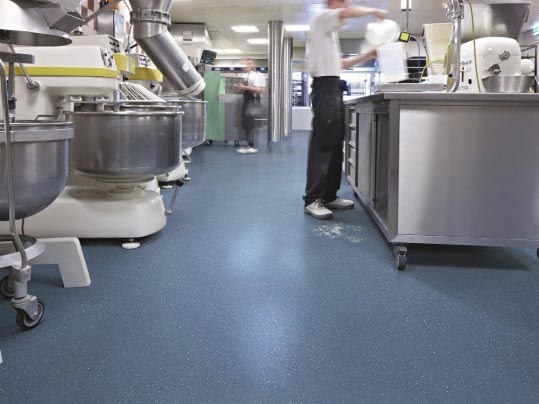This will require further investigation initially from your flooring contractor - it could mean a number of things - issues related to the application of the adhesive, late product placement, lack of post fitment rolling, sub floor moisture/cracking. It may be necessary to lift the product to fully understand the root cause(s).
Safety Flooring & Wetroom FAQ's
Listed below are the most frequently asked questions about our safety flooring & wetroom products.
If you would like to download technical/environmental specifications, BRE results, NBS specification, please visit the Safety Flooring & Wetroom downloads section.
For installation, cleaning & maintenance guides and videos, please visit the Installation & Floorcare section.
All available BIM objects for our Safety Flooring & Wetroom collections can be directly downloaded from the BIM page.
-
I have 'bubbles' appearing in my resilient floor covering soon after fitment. What does this mean?
I have 'bubbles' appearing in my resilient floor covering soon after fitment. What does this mean?
-
I am specifying a safety floor but don't know what the 'R' value means when assessing slip ratings?
I am specifying a safety floor but don't know what the 'R' value means when assessing slip ratings?
The 'R' value is a rating of between 9 and 13 based on ramp test results. The ramp test is a laboratory test to simulate the conditions commonly encountered in the workplace using oil as a lubricant and wearing specific footwear, a test subject walks a ramp with increasing gradients until a slip occurs.
The rating given is based on the angle of the ramp at which the slip occurs. When considering ramp test data, it is important to note that neither R9 nor all R10 floor coverings are safety floors.
-
Is surface roughness of the safety floor more important than the 'R' value when specifying a safety floor?
Is surface roughness of the safety floor more important than the 'R' value when specifying a safety floor?
Both test data can provide additional information when considering the suitability of a product where enhanced slip resistance is required. However, neither test result is a definitive measure of slip resistance when assessing safety floors. Safety floors must meet the performance requirements of EN13845.
In the UK market, the most important slip resistance test is the Pendulum test in which the measured result (the Pendulum Test Value or PTV) is related to the coefficient of friction of the floor surface.
-
Can I lay my resilient sheet floor covering directly on top of a raised access panel floor?
Can I lay my resilient floor covering directly on top of a raised access panel floor?
No. We would recommend over laying the access floor with a suitable grade 6mm plywood (such as Hanson SP101).
Alternatively, our Allura Flex tiles are designed to be laid directy onto the access floor in conjunction with a tackifier type adhesive (Eurocol Eurofix 542 tack plus), this loose lay systems allows the tiles to be lifted if access beneath is required.
-
Can Forbo floor coverings be installed in conjunction with third party acoustic underlays
Can Forbo floor coverings be installed in conjunction with third party acoustic underlays
Forbo Flooring offer a range of acoustic underlay systems that offer improved impact sound reduction properties.
These include:
• Corkment which can be used under any Forbo Sheet linoleum or vinyl floor covering offering an impact sound reduction value of 14 dB
• Vinylbase which can be used under Forbo sheet vinyl floor coverings offering an impact sound reduction of 18 dB.In addition, single stick acoustic solutions are available in:
• Linoleum, offering impact sound reduction values of 14 dB or 17dB
• General purpose sheet vinyl, offering impact sound reduction values of 15 dB to 19 dB
• Vinyl Safety flooring, offering impact sound reduction values of 18 dB
All Forbo products are supported by system performance test data, product compatibility, installation guidance, and wear life warranties.
For further information on product compatibility and installation guidance please contact us. -
What should a safety floor do?
What should a safety floor do?
Safety floors are expected to provide levels of slip resistance that reduce risk of slipping on contaminated surfaces. In addition, it is expected that these levels of slip resistance are maintained throughout the life of floor covering, that is to say the slip resistance properties should be sustainable.

-
Forbo Flooring Statement on Slip Resistance Testing
The PDF download is a copy of an internal document stating the Forbo Flooring position on slip resistance testing and assessment of slip resistance performance for floor coverings.
Download the Forbo Flooring Statement on Slip Resistance Testing